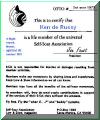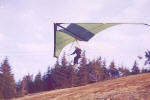|
1970 1971 1972 1973 1974 1975 1976 1977 1978 1979
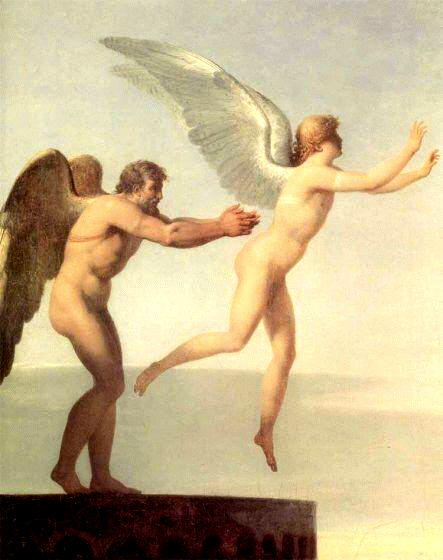
Hang Glider History Timeline ==>EnterData +
Send your favorite timed item to
timeline@hanggliderhistory.com
Notes: Link prefix with "g" is a generalized Google search.
Prefix with a "w" is a leading Wikipedia file on topic.
|
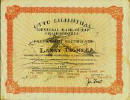
See medium size of historical certificate.
See very high quality 2 mb size of same.
|
- Scott Sled hang glider flight base jumping, father and son in Venice, CA.
- Send facts on Low & Slow to LowAndSlow@hanggliderhistory.com CD? tcNtes
- Francis Melvin Rogallo granted an honorary doctorate degree from Kite Information and Technology Exchange Society of America for his contributions in research on the Rogallo wing that found its way into the foundations of kiting, hang gliding, and other aircraft. This adds to Dr. Francis Rogallo's legacy.
- The Jack Lambie circle spins. Hang Loose project at a school. Plans follow. World coverage results. Near Long Beach, California, Jack was a summer-school principal at Collins School summer session where he also taught a class in science and crafts. Read here part of the story. Hang Loose was a large low cost tailed biplane hang glider using parallel-bars for the pilot to adjust for pitch and leg-mass swing to control roll/yaw, if possible. Media attention continued building the appetite for hang gliding that had been building from many other influencing streams (aeromodelling, soaring, gliding, Rogallo phenomenon, kiting, water-ski kiting, space re-entry test vehicles, art, popular aviation, EAA, etc.). Lambie added a "for everyone now for pennies" deal to get flying by way of school groups and homebuilders. He carried with him his profound associations with the soaring community and aviation community which included Richard Miller who had already been influencing low-cost light personal flight through writings, modeling, exampling, and a carrying of only part of the Barry Palmer legacy via prior Bamboo Butterfly fame and spread-to-the-world plans. Media coverage was extensive and effective. Missing in the article linked is the fact that Richard Miller had already broached the meet's idea with Self-Soar Association; the actual planning and pre-meet meetings fully involved S-SA, Miller, Lambie and others; Low & Slow was one of the key vehicles for announcing the planned meeting to be on May 23, 1971. Lambie and Miller shared their mailing lists with Faust as S-SA did mailings and article support for the planned meeting, a meet that was to be "unplanned." Special note: the jib-sail Bruce Carmichael aluminum Rogallo-winged machine had been priorly demonstrated to Faust in San Clemente, California, along with Richard Miller at a hill very near Bruce's home at the beach; Bruce Carmichael, a professional engineer had professional design experience with hydro-kites that ended up being a pleasant common-interest bridge between Bruce and Faust. Bruce Carmichael would later attend and participate in high-level conferences of flying wings where Jack Lambie would also be in attendance.
- .
|
1970
EnterData+
[_top_] |
|
|
1971
EnterData+
[_top_]
|
- Petrel by Bob Trampenau: see history at Seedwings (design in getting some 2008 modern materials redesigning). See his history on the Petrel, Sunseed, and changes. See 1975 revolutionary Sensor.
-
| Hang Glider Weekly
was publisher of some key facts on the innovative company
Seedwings
with founder, designer, inventor
Bob Trampenau. We have strong reason to look to roots of VG
--variable geometry-- in Seedwings. The company's Sensor's fiberglass curved wing
tips and the enclosed cross bar were invented by Trampenau and
first flown in 1976 and shown in Hang Glider Weekly. He
further invented wire braced washout struts in 1978 now used on all
topless hang gliders and the wrap-around Mylar leading edge pocket in
1979 all before the UP Comet. Trampenau continued inventing; and
he first HGMA certified the curved wing tip, enclosed cross bar,
and an all-wire trailing edge reflex bridle stability system and
VG. The
wire-braced washout struts and wire-reflex bridles are the two most
important stability safety features on today's hang gliders. Another
safety-and performance-feature that is significant are the flaps on a hang
glider. Seedwings owner Bob Trampenau invented the current flap system in
1992, and as yet no one has copied it. The Seedwings
trademark is internationally operated out of the headquarters in California. |
- HG history enthusiast Scott Perkins lets us have a closer look at Volmer Jensen's VJ-23 cantilevered hang glider. The VJ-23 has been used in various ways, some powered. Seats. Who has gone prone with the it? Click to enlarge. Caption information by All is invited. N474VJ for one of the shown versions; notice Volmer with the swing seat beneath his belt in front of him; he got into the seat after launching. The wheels are for safety. Notice the airspeed indicator. The first VJ-23 is shown at the Dockweiler site where Richard Miller in mid-60s flew the Bamboo Butterfly with friends.
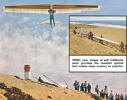
 No wheels or seat here. No wheels or seat here.
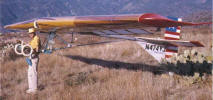 Year? Wheels and seat. Year? Wheels and seat.
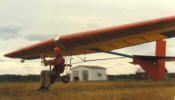 Year? Notice the different sitting and wheel arrangement here. Year? Notice the different sitting and wheel arrangement here.
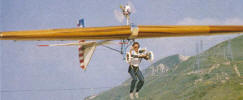 Year? Powered. Year? Powered.
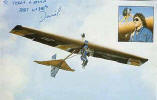 Year? Powered assist. Duckhams Channel flight Year? Powered assist. Duckhams Channel flight
 Year? Year?
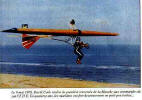 Year? Year?
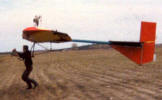 Year? Year?
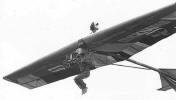 Year? Year?
|
1972
EnterData+
[_top_]
Linknife
|
|
|
???
1970s
circa
EnterData+
[_top_]
|
- Stephan Nitsch had first attempts with hang gliders in 1973, Hanover Germany.[[ [ ] Where was his first flight?]] He is 2007 contemporary hang-glider-history author and hang-glider pilot. His main historical interest is Otto Lilienthal. His Lilienthal and replica, book projects can be seen at www.JumpNFly.here.de See also Chanute biplane. See movie.
- Mike Miller enters hang gliding and begins to make a difference. " My name is Crista Miller. My father Mike Miller helped pioneer the sport of hang gliding. He was sponsored by Bill Bennett and taught many new pilots at Escape Country in California from 1973, and then moved to Elsinore, and owned the Elsinore Valley Hang Gliding Center until early 1980's. (We will be publishing more on Mike Miller [ ] )
- Brian Harrison flew his first HG in 1973. See his advancing aviation
career HERE. Current:
Elf motorglider.
He is in
one photo
on this page.
- Dial Soap TV commercial featured the flying of an experimental hang glider: Koman-Faust cross-spar-less ....!
This was perhaps the first bowsprit cross-sparless hang glider in the
renaissance. In 1800s there were examples of bowsprit cross-sparless flying
machine, e.g. the flying machine of
Frederick William Brearey. No Australian influence; VG base.
National coverage on TV. Faust flew the glider in Simi Valley, CA, as wll as
took the shower shown. Residuals were fully invested to buy a larger printing
press to publish larger issues of Low & Slow and Hang Glider, and
Hang Glider Weekly.
- Dan Poynter
 publishes first modern major book on Hang Gliding. One of our editors (Faust) was flying on the back cover of the first edition book. It is still selling. His first book was on parachuting. He is self-publishing guru. He spent hours in the Low & Slow and Hang Glider Weekly office with Faust. Big plus to the hang gliding movement---still is. publishes first modern major book on Hang Gliding. One of our editors (Faust) was flying on the back cover of the first edition book. It is still selling. His first book was on parachuting. He is self-publishing guru. He spent hours in the Low & Slow and Hang Glider Weekly office with Faust. Big plus to the hang gliding movement---still is.
- Tri-State Kite Sales begins with some Bennett devices. Mark Smith. Mark had started flying earlier in a local water-ski club with an Obrien kite (Rogallo-winged kite). (Spelling?)
- May 10, 1973, Volmer Jensen files for an ornamental design patent for a hang glider, click through HANG GLIDER Jensen et al.
Patent number: D233426
Filing date: May 10, 1973
Issue date: Oct 1974
In mild breezes he could just step off of a slope and begin soaring on 20' high ridges. His first private-public flight was (witnessed close up by Irv Culver and Joe Faust) off a concrete bridge in a riverbed in Southern California. Then he had a larger demonstration at Dockweiler Beach. Three-axis control, foot-launched. Notice that this is not a process patent. gVJ1 See above 1972 for VJ-23 photos and videos.
- Tom Peghiny gTP1 | http://rlsa.bydanjohnson.com/index.cfm?b=4&m=1&i=52 | Teen Sky Sports ....
- http://www.google.com/patents?id=g3F8AAAAEBAJ
-
|
1973

EnterData+
[_top_]
Linknife |
- Custom Car ( August, 1974) ???
-
Finsterwalder & Charly
- airsport equipment since 1974
- Canadian National Kite Flying Championships in Nelson B1
- Date yet to be determined: http://www.youtube.com/watch?v=JsLZjCnCISU Video of Rogallos in Europe
- Pete Plumb
- Photo of Porta-Wing with
Karl Stice at the pilot position:
Image
- Bob Dickenson (not John, not Tom ) received USHGA Presidential award. http://www.ushga.org/award_recipients.pdf
- Cover of Popular Science __________ Quicksilver. Copies on eBay.
- Hang glider by James R. Bede
Abstract A hang glider in the form of an aerial wing of airfoil shape is disclosed. 
The wing is defined by an outer envelope of flexible material inflatable to the airfoil shape and having a plurality of chambers therein each receiving an inflatable bladder. Air inlet openings are provided in the bottom portion of the envelope adjacent the leading edge of the wing. Either the bladders or the chambers are inflated with a gas lighter than air and, during flight, air enters the openings and fills the available space in the others of the bladders or chambers to provide a complete smooth airfoil shape for the wing. Shroud lines are employed to suspend a person beneath the wing during flight.
Patent number: 3944169
Filing date: Jul 12, 1974
Issue date: Mar 16, 1976
Inventor: James R. Bede
|
1974
EnterData+
[_top_]
[ ] What has the paragliding community done with hard-inflated span-wise
airbeam chambers,
if anything,
to affect anti-deflation?
Inflatable structures
EnterData+ |
- Seedwings Bob Trampenau, inventor, leading designer, manufacturer, consultant The Sensor design was revolutionary.
- Home video of a Jack Lambie inspired Hang Loose biplane hang glider: http://www.youtube.com/watch?v=9s3YEEhOO3o Lokken Family Home Movies
"Homebuilt Hang Loose hange glider. Built 1975. Cost $25 in 1975. Made from yellow pine, styrafoam, poly plastic, bailing wire and bottle caps."
- Malewicki, Douglas J. (Irvine, CA, US) Application Number:574308 Filing Date:05/05/1975 Publication Date:01/17/1978 U.S. Patent 4068810 Combination motorcycle and hang-glider
- Hang glider Frank J. Bartolini
[Filed on Otto Lilienthal's birthday and Michael Markowski's birthday:]
Patent number: 3995799 Filing date: May 23, 1975 Issue date: Dec 7, 1976
Inventor: Frank J. Bartolini  "Abstract: A biwinged high performance collapsible hang glider having a simplified integrated frame, having a reinforcing cable system, having a variable camber upper swept wing including a sail, with non-rigid leading and trailing edges, and a flexible batten, having a bridge spacing the sail from the frame, having a lower undercambered sail wing including a sail with a tubular leading edge and nonrigid trailing edge, having an optional collapsible Y-tail modification including sail with non-rigid leading edge and hinged tubular-trailing edges, having a low wing-loading effect, a high lift-drag ratio, a high glide-ratio, a low sink-rate and minimal spiral instability, yielding the capability of effective body-english pilot control for short duration training flights or for long duration cross-country flights, and being collapsible so as to be readily transported by a common passenger vehicle." "Abstract: A biwinged high performance collapsible hang glider having a simplified integrated frame, having a reinforcing cable system, having a variable camber upper swept wing including a sail, with non-rigid leading and trailing edges, and a flexible batten, having a bridge spacing the sail from the frame, having a lower undercambered sail wing including a sail with a tubular leading edge and nonrigid trailing edge, having an optional collapsible Y-tail modification including sail with non-rigid leading edge and hinged tubular-trailing edges, having a low wing-loading effect, a high lift-drag ratio, a high glide-ratio, a low sink-rate and minimal spiral instability, yielding the capability of effective body-english pilot control for short duration training flights or for long duration cross-country flights, and being collapsible so as to be readily transported by a common passenger vehicle."
- Patent number: 4029273
Kite
Filing date: Nov 13, 1975 Issue date: Jun 14, 1977
Inventor: Julius M. Christoffel, Jr. Abstract
An inflatable delta wing kite having a single air chamber formed of a bulbous nose portion and three frusto conical shaped tubular portions forming structural beams, one beam extending along the central longitudinal axis, and the other two forming the leading edges of the kite, the terminal end of the central beam forming a filler tube; generally triangularly shaped, uninflated sections forming airfoils are located between the central and edge beams ... -
-
Established in 1975,
Commission International de Vol Libre (CIVL – Hang Gliding and Paragliding
Commission) is an Air Sport Commission (ASC) of the Fédération Internationale
Aéronautique (FAI), founded in 1905 in Paris, France, and today based in
Lausanne, Switzerland. This organization covers only
part of
hang gliding
niche activities
in its focus.
Self-Soar Association (S-SA) embraces all
hang gliding
niche activities on earth and beyond earth.
http://www.fai.org/civl-news/36379-2012-civl-handbook
- Concave parabolic arch kite
Peter J. Pearce et al
U. S. Patent number: 4018408
Filing date: Jul 15, 1975
CPARK1
-
http://www.google.com/patents?id=Pz00AAAAEBAJ
-
- [#] TV
news: CBS' 60 Minutes "Ever Since Icarus" aired on August 31, 1975.
The following photograph is a still shot during part of the interview. The
photograph is strictly a CBS copyrighted property given for Hang Gliding
Timeline only; any further use of the image must obtain permissions from CBS.
Photo: (our first showing of the photo: July 23, 2012)
http://energykitesystems.net/HangGlidingTimeline/CBScopyrighted/48871_2_60MinCBS.jpg
Mike Wallace, at right, interviews a hang gliding enthusiast for 60 MINUTES.
Segment titled, 'Ever Since Icarus' initially aired on August 31, 1975.
Copyright © 1975 CBS Broadcasting Inc. All Rights Reserved. File: 48871_2
The image is of Joe Faust and side view of the late Mike Wallace. Wing made for
the occasion by Seagull Aircraft of Santa Monica, CA, owner Mike Riggs. The
flight involved used an empty lot near Olive View Hospital in Sylmar, CA. The
launch is known now as the 1500 ft launch near West Towers (needs verification).
Mike Riggs duct taped a camera to one end of the spreader, and a balancing
rock to the other end of the spreader ... after this still photograph was taken.
http://www.energykitesystems.net/hgh/t8.html#CBSphotoIcarus
The photo apparently appears in a paper book
“60 Minutes: 25
Years of Television's Finest Hour by Frank Coffey” – appears on page 68,
published in 1993.
[
] We ordered book from Amazon on July 23, 2012, to verify page contents.
-
|
1975 |
|
|
1976
EnterData+
[_top_]
|
The Award winning DVD of the
1976 Dog Mountain
US Hang Gliding Championships
is now ready to ship.
Send $34.00 to
Orca BC
PO Box 8
Onalaska, WA 98570 | |
- Prentice 1977-1978 Manufactured Wills Wings under licence in the UK.
- Patent number: 4116406
Filing date: Jun 17, 1977
Issue date: Sep 26, 1978
Inventor: Paul D. Hamilton
Abstract
A high performance hang glider includes a frame to which is attached flexible sail fabric to create a delta-shaped Rogallo wing. The sail is of double thickness throughout a substantial portion of the wing area to provide an
Hang glider having inflatable airfoil Paul D. Hamilton envelope inflatable in flight by air entering an intake opening at the nose of the wing and exhausting through nozzles in the underside of the wing tips. A more efficient double-surface airfoil is thus provided which automatically changes its camber in response to changes in speed for optimum performance.
- HPA Ikarus (Icarus) ground-effect-only man-powered aircraft flies in ground effect just a week after the Gossamer Condor won the big Kraemer Prize. The Ikarus took about 0.5kW to fly.
Theoretically we can fly a man-powered craft with less power in ground effect. In ground-skimming during landing we often fly our hang gliders in ground effect; some hang glider pilots specialize in bleeding every inch out of the ground-effect flight sector for fun; appropriate wheels or skid can be used to have safer experiences when flying in ground effect. One needs to prevent catching the airframe on ground obstacles or the ground itself, as beaking or such catches can cause abrupt stops with perhaps fatal results. Be sure to get professional instruction for hang gliding.
- Kris and Joe Greblo meet at Dockweiler in May of 1977.
|
1977 |
- Hang glider author Stephan Nitsch successfully flies a hang glider.
- Hang glider harness Daniel C. Chadwick
Patent number: D252716 Filing date: Jun 21, 1978 Issue date: Aug 28, 1979 Inventor: Daniel C. Chadwick Hang glider harness
- June 1978. Bosson
|
========Machine
translation
from French, we quote for study and critique: =========
The glider was "invented" [Ed:
sic, locally and regionally, but not globally, of course]
in Mieussy Haute-Savoie, 35 years ago While Mieussy celebrates birthday
paragliding this Saturday, June 22, back at the history of this invention
born in 1978 on the tip of Point Pertuiset. France 3 AlpesPublished
22/06/2013 | 3:10 p.m. ,
parapente_2.jpg
http://alpes.france3.fr/2013/06/22/le-parapente-ete-invente-mieussy-en-haute-savoie-il-y-35-ans-275287.html
June 1978. Bosson , Bétemps and Bohn already illustrated in competitions
parachute. Their specialty: precision landing. But difficult to practice
regularly when necessary, for each jump mobilize a plane and therefore pay
for the fuel. "If instead of jumping from the plane, it jumped from a high
point?". In answering this question, the three friends invented
paragliding. The high point of the tip Pertuiset . The landing area:.
Mieussy Mieussy then welcomes the France team skydiving but also in
Germany. Yet it still will wait four years to pass paragliding training
method to separate discipline. It will take one of these paratroopers,
only interested in landing, take the time to fly. Now world famous "spot"
of Pertuiset sees off hundreds of paragliders each year.
[[Tip of link from RM; thanks!]] |
- "David Cook, another Englishman, made the first microlight flight across the English Channel on May 10, 1978, in a VJ-23 powered by an engine as small as 101cc, over the same route flown by Louis Bleriot in 1909. " from http://www.seeingisbelieving.org.uk/microlightadventure/education-aviation.asp which see for other notes.
| The research on this is still ongoing. Much more will be linked regarding the Canard 2FL. Yet to find out is the circumstances of Dr. Hans Farner's own final moments; it seems clear that notes in the literature are sometimes incorrect as he seems to get mixed up with the distinct other person Prof. Schürch.
We have two speakers so far regarding an effort to clarify matters about the designer of the Canard 2FL:
Canard 2FL
(Jan. 8, 2008 from Gary Osoba)
I have received confirmation from the son of Ernst Ruppert, one of the partners in Aviafiber,
that Dr. Farner was not involved in the fatal Canard 2FL test flight. He writes:
" Hans Farner was not involved in the Canard accident. As far as I know he never was a Canard-pilot. The fatal accident was with Prof. Schürch from Zurich University which was quite a story since the University got involved in the development of the new Canard SCM version after the accident. It was not simply caused by stall/spin but was a far more complex chain of critical maneuvers based on the difficulties because the sailplane pilot Schürch was confronted by the unusual control system of the Canard 2FL."
Best Regards,
Gary Osoba
(Jan. 8, 2008) Professor Michael Schönherr shares with us:
I remember the following:
1. At the end of 1978 or 1979 I got the message, that a professor of the ETH Zurich was killed by a Canard 2FL - accident, because, as reported, he had used the controls the wrong way.
The Canard 2 FL managed the directional control by rolling the front wing, the "canard-wing", so the lift of the front-wing delivers, when in a bank-angle, a lateral force-component and a torque around the vertical axis of the plane.
2. Later I heard from a person, involved in the accident-investigation, that the accident's reasons were clearly found:
Let´s imagine, that the glider makes a strong yaw-movement to the left. The pilot wants to compensate for that and rolls the canard-wing strongly to the right hand. Because of the high yaw-angle, the front wing however, with his now high right hand bank-angle comes into negative angle of attack, his lift becomes negative and delivers a lateral force-component to the left, just the opposite, that was intended. This way the Canard 2 FL plane came completely out of control until the impact.
Thus the investigation result.
(In 1980 I constructed a flexible model canard myself with the same front-vector control principle, with the difference that the canard wing could swivel down around a hinge in his leading edge, so that he did not accept negative lift. Thus I never had any control-problem, see also:
http://www.net-art.de/mech/Geschichte4/Drachenente/default.htm )
Professor Michael Schönherr |
| |
|
1978 |
| Gossamer Albatross G1
|
1979
[_top_]
|
| Alaska
: The History of the
Arctic Air Walkers
"Alaskan
Sky Sailors Association, had formed in 1973 or 1974 and for a time had over a
hundred active members flying at Hatcher Pass, Eagle River, Girdwood, Fairbanks
and other places in large numbers." |
|















